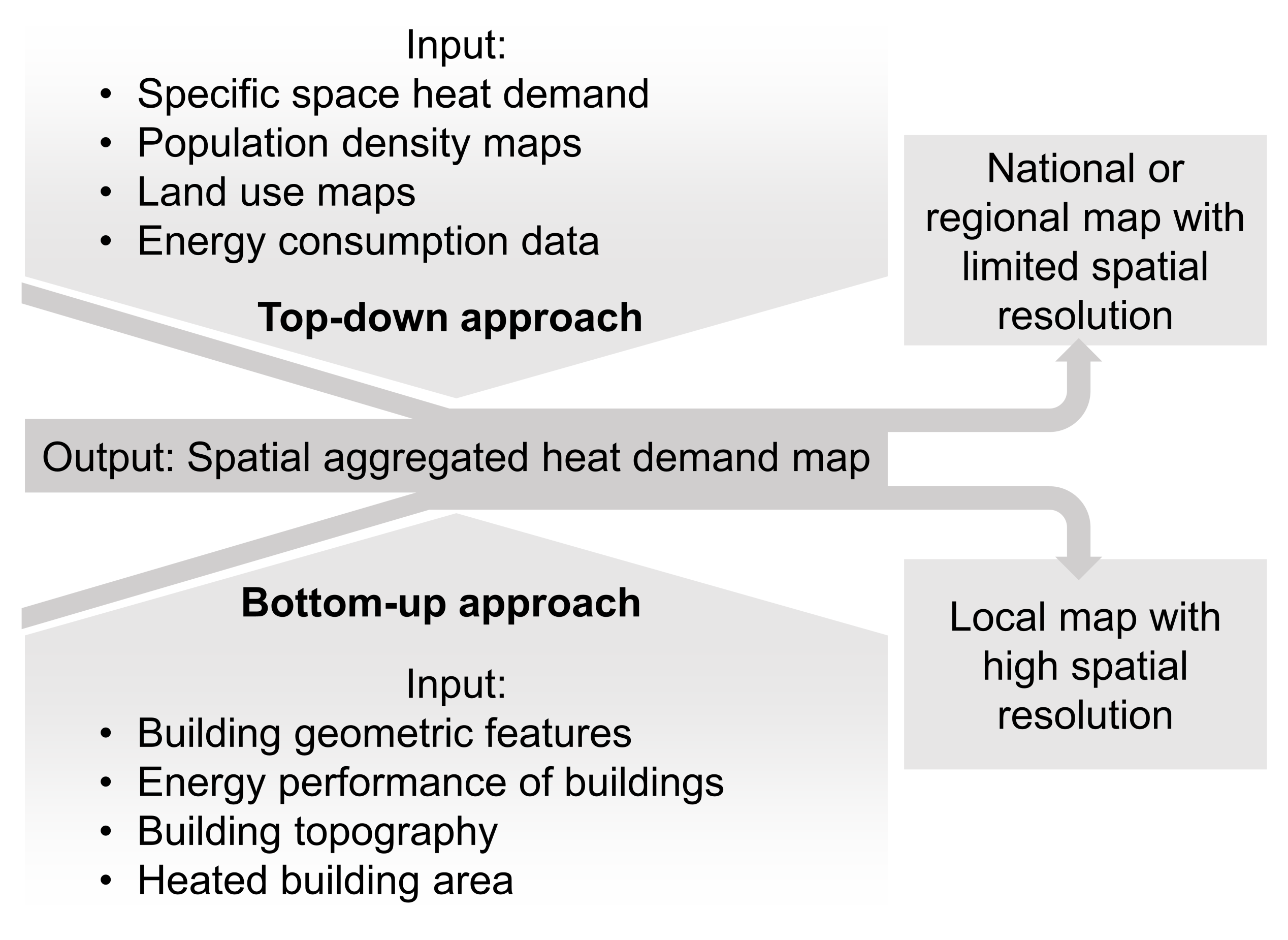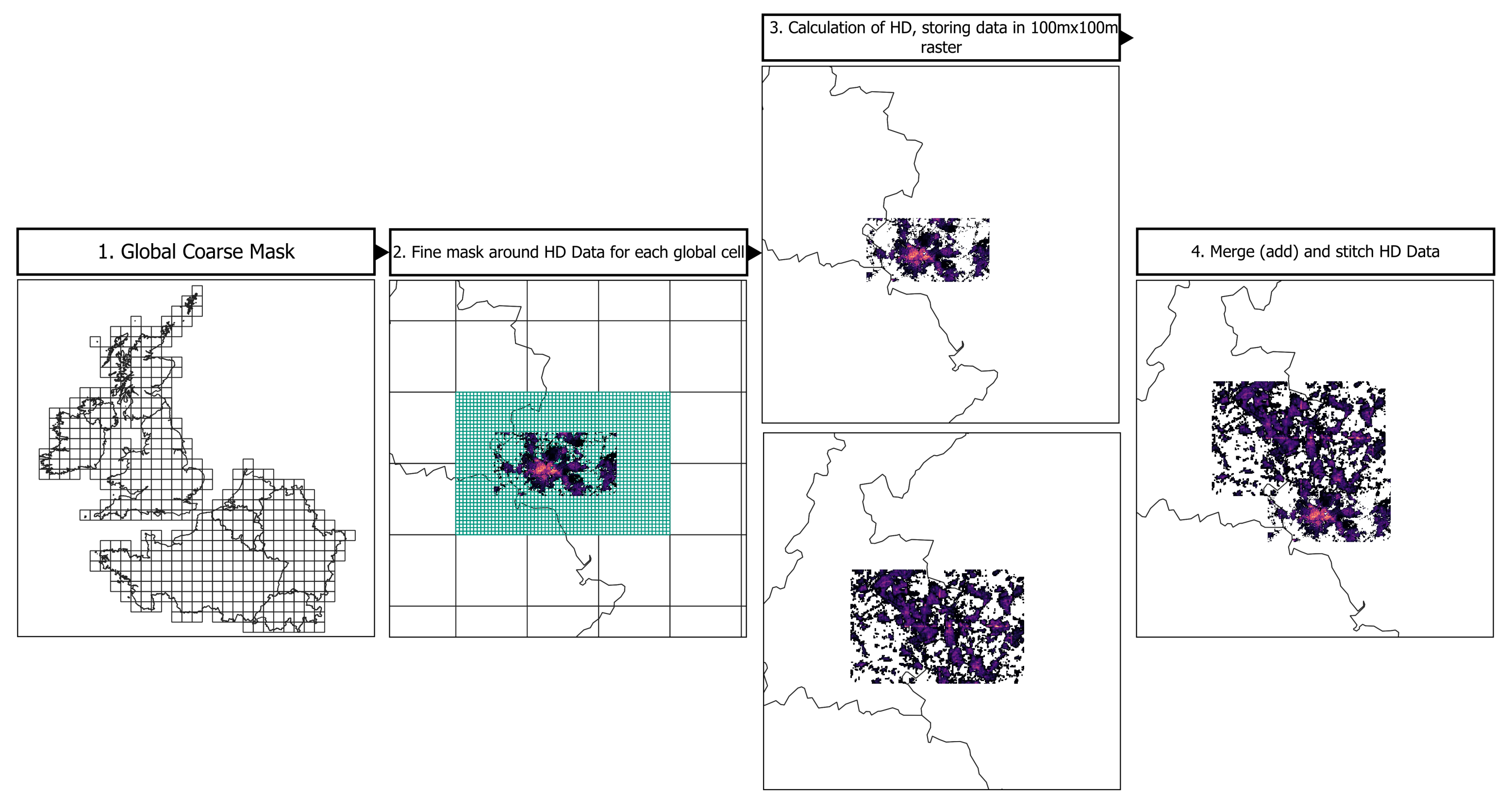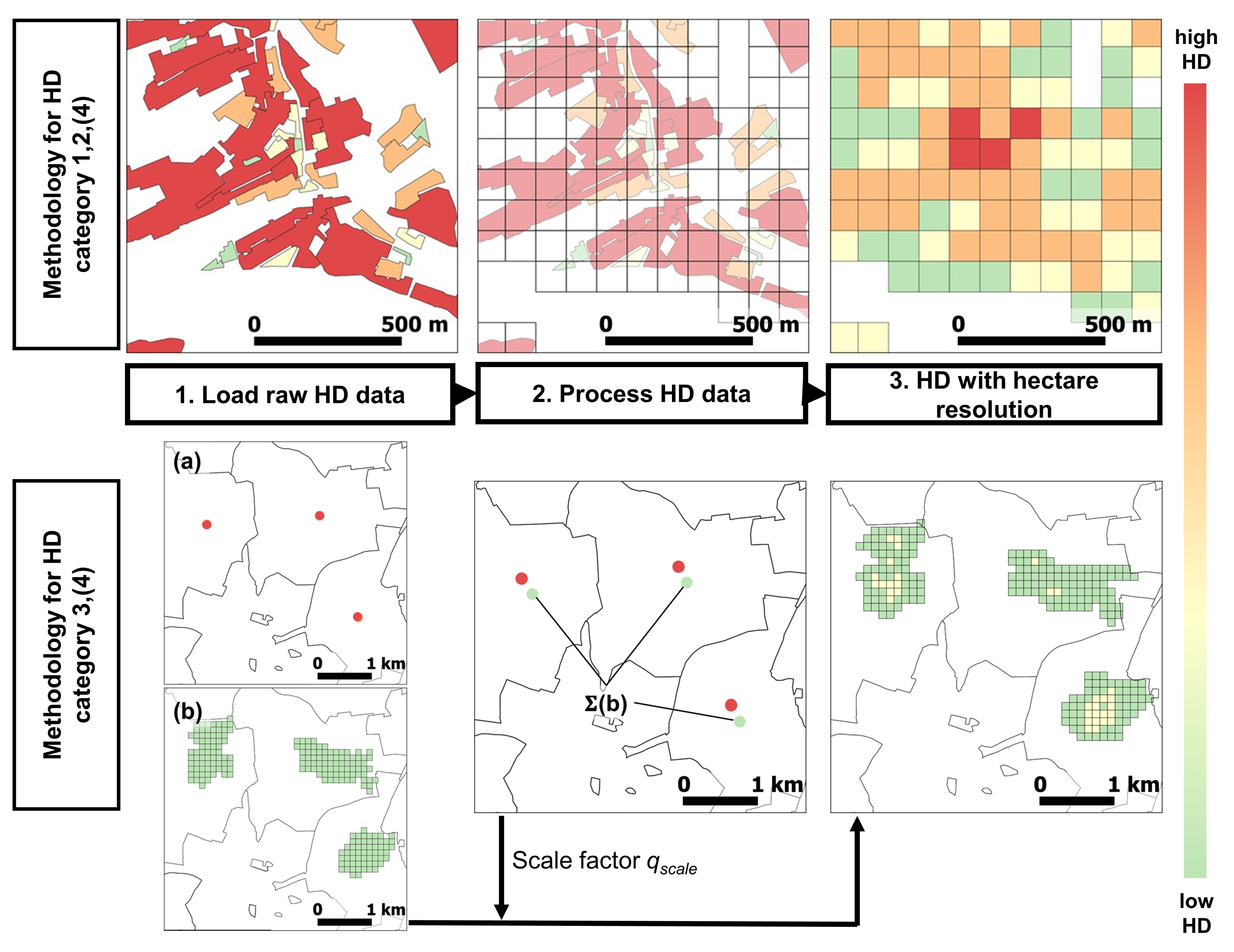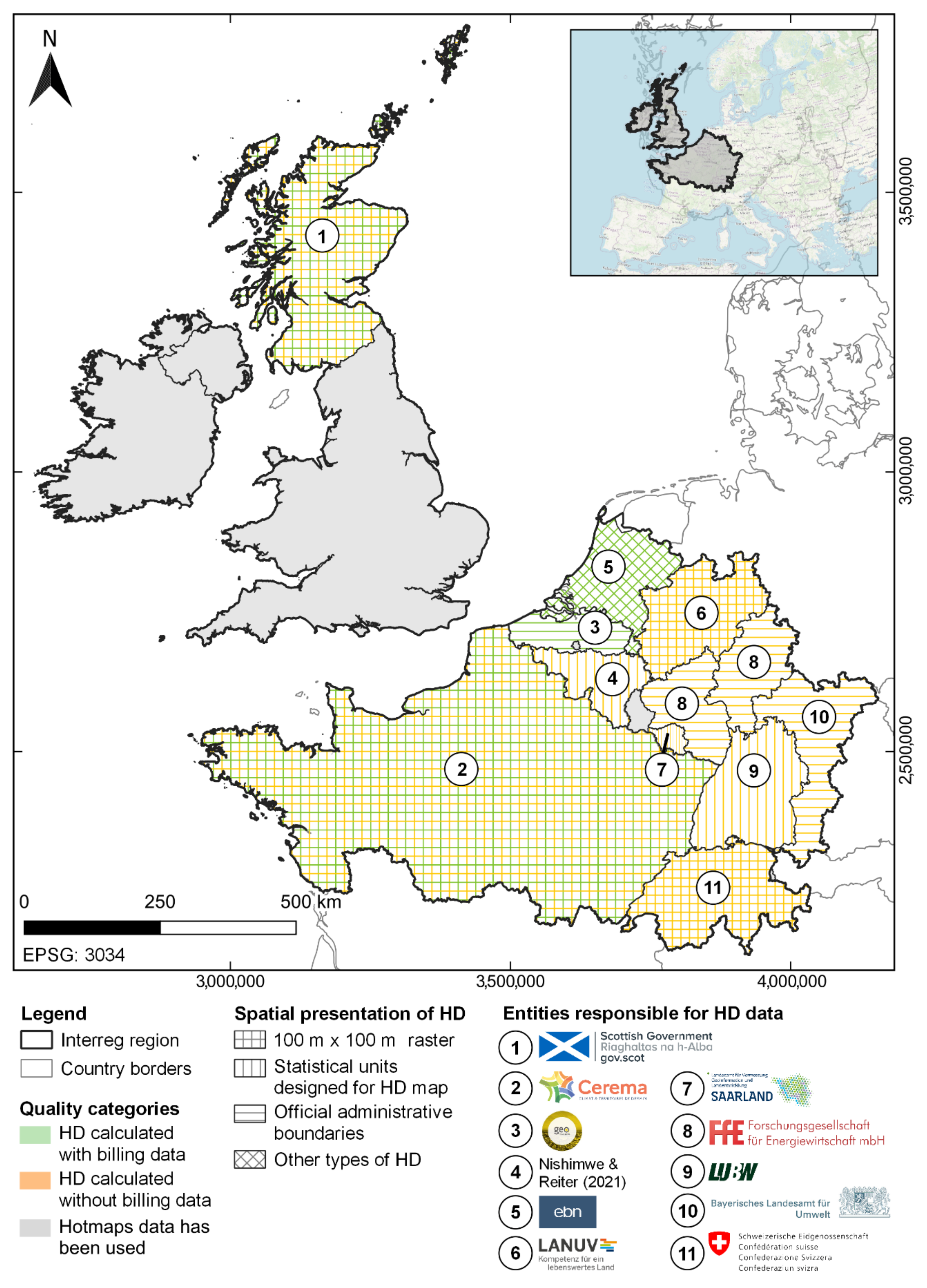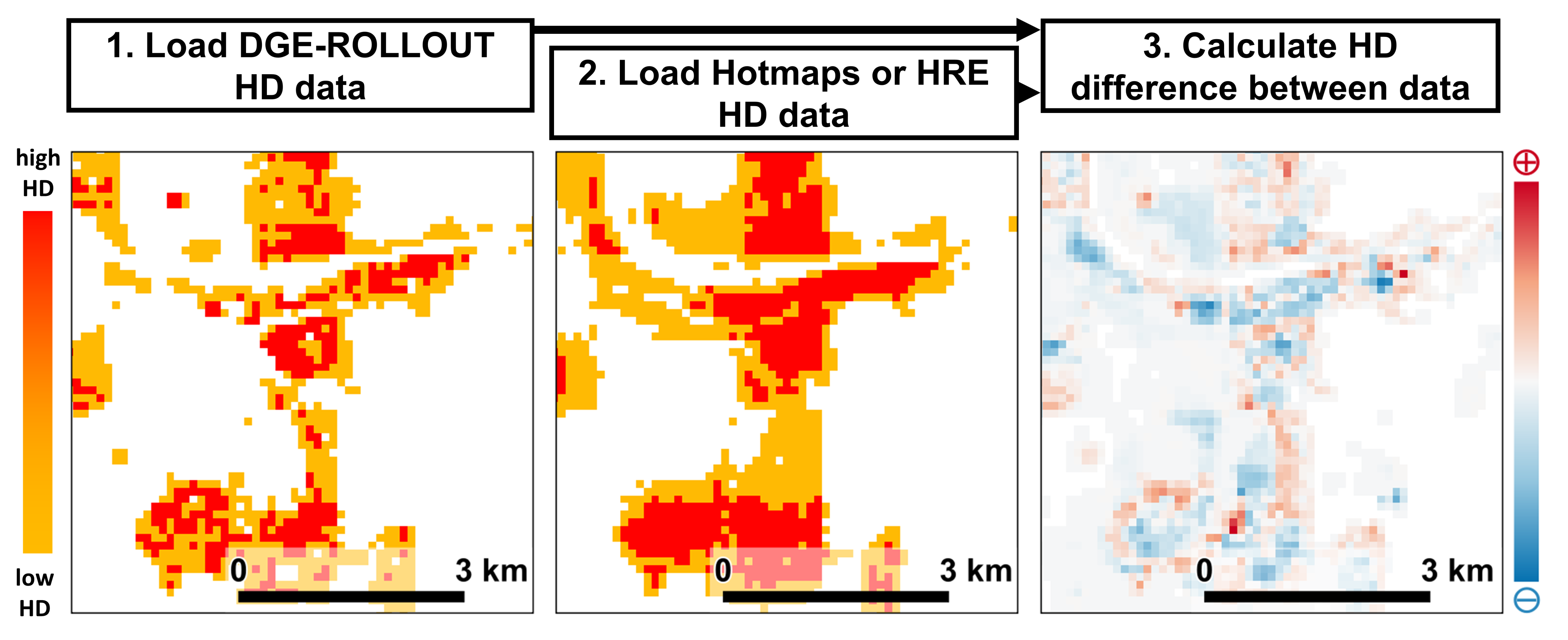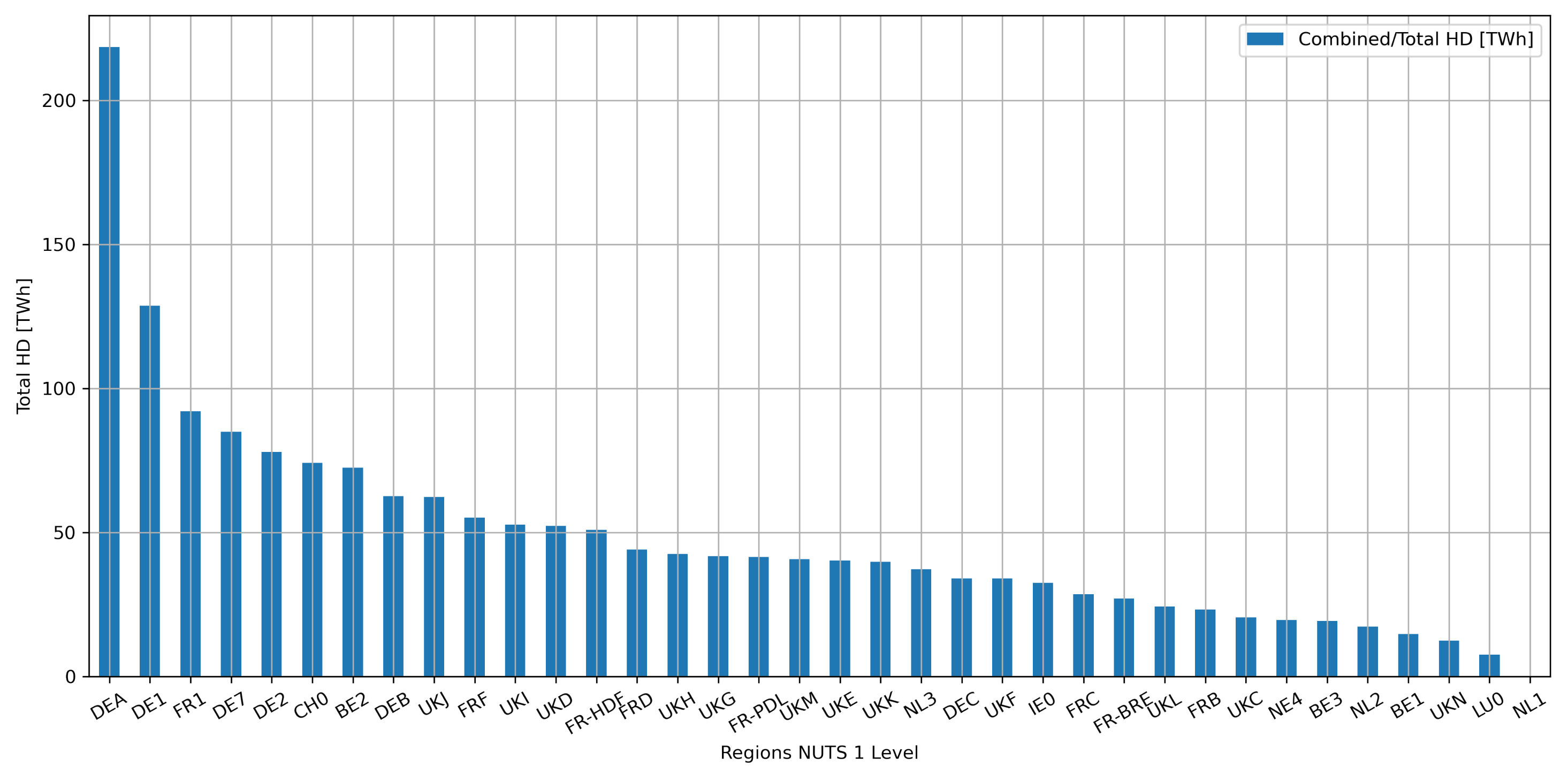1. Introduction
Reducing greenhouse gas emissions by replacing fossil fuel-based energy systems with sustainable and climate-neutral systems is a major focus of the Green Deal of the European Union (EU) [
1]. As 75% of the primary energy and approximately 50% of the thermal energy are still produced from fossil fuels, the EU has funded several projects regarding an efficient heat demand (HD) mapping to address possibilities for the implementation of sustainable heating systems such as the dimensioning of heat pumps, the setup, and extent of district heating networks or the required power of a (geothermal) power plant [
2,
3,
4,
5]. The European Commission further proposed in the recast Energy Efficiency Directive that heating plans will be mandatory for municipalities above a threshold of 50,000 inhabitants, which will require comprehensive heat demand analyses on local to regional scales. Demonstrated by countries like Denmark, the Netherlands, Scotland, and portions of Germany that have already undergone heat planning processes, the anticipation arises that not all municipalities will possess standardized consumption data of the same resolution. Hence, tools for harmonizing and evaluating heterogeneous consumption datasets will be particularly essential for heat demand analyses at the district to the regional level.
To address a scenario in which local to regional heat demand analyses with appropriate and user-friendly tools will become mandatory, this study has been conducted within the framework of the Interreg North-West-Europe area (Interreg NWE) project “Roll-out of Deep Geothermal Energy in North-West-Europe” (DGE-ROLLOUT) [
6,
7,
8,
9]. As part of the project, the goal of this study was to produce harmonized heat demand maps for the project area on one hand, and thereby develop a sufficient method that can be used for tool-development for heat demand analysis on variable input datasets and scales on the other hand. According to the Energy Efficiency Directive, the member states of the EU must map their HD on a high spatial resolution [
10]. National HD data of several member and non-member states were available for this study (Belgium [
11], Switzerland [
12], Germany [
13,
14,
15,
16,
17], France [
18], The Netherlands [
19,
20], and Scotland [
21]).
The HD describes the energy in megawatt hours (MWh) needed for space and water heating over a certain area (e.g., 100 m × 100 m = 1 ha) and time period (e.g., one year after the Julian calendar with 365/366 days). Usually, the heating differs between the residential/domestic and commercial sectors. Residential buildings are exclusively used for private usage, e.g., single- or multi-family buildings. Commercial buildings refer to any property used for business activity, e.g., office, retail, and lodging. The commercial sector on the DGE-ROLLOUT HD map also includes some institutional buildings, e.g., medical, educational, religious, and governmental buildings. While minor contributions of process heat may be included in the heat demand input data for these buildings, large industrial processes or processes that require large amounts of heat are not included. Industrial, military, and infrastructural buildings are not included in the HD maps as their data are not publicly available and require individual approaches to characterize the heat sources and sinks, e.g., via a pinch analysis.
For the development of an HD map, a top-down or a bottom-up approach can be used, which differ fundamentally in their methodology (
Figure 1). The first calculates HD on a large scale, usually on a national level or on lower Nomenclature of Territorial Units for Statistics (NUTS), while using publicly available, low-resolution data. The latter uses high-resolution data on a regional level, usually a city or a Local Administrative Unit (LAU). However, this more detailed approach significantly increases the computational and processing requirements. Because this might represent a hurdle for many municipalities in local to regional heat demand analysis as a fundamental element of municipal heat planning, methodological simplifications as preparation for the implementation of end-user tools are inevitable.
The two projects with the largest and most comprehensive dataset for spatial mapping of HD on a European level are Hotmaps [
23] and the Pan European Thermal Atlas of Heat Roadmap Europe (HRE) [
24]. Both projects use well-designed top-down approaches, based on a strong level of scientific expertise [
25,
26,
27,
28,
29]. The Hotmaps project uses a statistical approach, whereas HRE uses an econometric approach. Both projects present their resulting heat demands on hectare resolution (100 m × 100 m). Besides these two projects, the development of HD maps has become an emerging subject of research in recent years. A profound literature review of HD maps until 2019 has been compiled by [
30]. A detailed analysis is usually done at the city or district level, aiming at evaluating the (pre-) feasibility of district heating systems or regional development plans [
31,
32,
33,
34]. The traditional approach to developing HD maps is to use a geographic information system such as QGIS or ArcGIS [
22,
35,
36]. Recently, more approaches using scripting languages, like R or Python, have appeared [
37,
38,
39]. Since the datasets and methodologies are usually not publicly accessible, these local studies were not included in this study. An exception is a recent study for the Walloon region in Belgium, where no other HD data are available [
40]. Many of the aforementioned studies do not provide the tools (i.e., scripts) to replicate the results. Further, they usually focus on smaller regions whereas the developed methodology in this study is not restricted to any administrative level or level of resolution.
Within the framework of this study, the open-source Python package PyHeatDemand was developed [
41]. Rather than aiming to replace any existing heat demand mapping methods, it focuses on providing a methodology for administrative entities to harmonize heat demand data, thereby improving district heating plans. Three HD maps of the Interreg NWE area are presented in this study, applying the developed procedures using publicly available consumption data to identify hotspots of the residential HD and the commercial HD, and both combined on a hectare scale for the observation period of one year (Julian calendar). The developed approach is easy to apply to different categories of data and allows for the reproducibility of the outcomes, a constant update of the maps once new data becomes available, and an extension of the study area for previously unmapped territory. The resulting HD maps are validated against the HD maps from Hotmaps and HRE (only a top-down approach). A combination of a bottom-up and top-down approach is implemented to deliver a higher resolved result than previous mapping projects. Major sweet spots for investment projects, for example, heat production from deep geothermal power plants using doublet systems or the extension of existing or development of new district heating systems, are assumed in areas with a high degree of urbanization, as these areas have usually existing district heating networks and a high customer density.
4. Discussion
The developed workflow allowed for the computation of three uniform heat demand (HD) maps for the residential sector, and the commercial sector, and both combined as a total, for the Interreg NWE region. The HD maps refer to a purely spatial component and do not include a temporal component, e.g., the influence of climate or singular events like particularly cold winters. The reason is the raw HD data, which were calculated during different periods of time. Consistently deriving the reference year or the time span for which the HD data has been calculated from the methodology description for each region is not possible.
4.1. Spatial Distribution of Heat Demand on a National Scale
The statistical analysis reveals that only three countries (Germany, Great Britain, and France) account for ∼80% of the residential, commercial, and combined total heat demand while the remaining six countries account for ∼20% of the heat demand in the Interreg NWE region. The total heat demand covers only 16.1% of the entire Interreg NWE region. Apart from Germany, 2/3 to 3/4 of the total heat demand is attributed to the residential sector while 1/4 to 1/3 is attributed to the commercial sector. In Germany, the share of the commercial sector is noticeably higher (43.9%) and the residential heat demand is accordingly lower (56.1%). This discrepancy is associated with the fact that the Interreg NWE area for Germany covers the industrial centers in North Rhine Westphalia and in southern Germany with their associated commercial sectors adding disproportionately to the heat demand while more rural areas such as in northern and eastern Germany are not included in the calculations.
The average heat demand per heated area indicates that the heat demands are more decentralized in countries such as Switzerland, Germany, Great Britain, Luxembourg, the Netherlands, or Belgium (138.5 MWh/ha to 197.8 MWh/ha) while the spatial distributions of heat demands in countries like Ireland, Scotland and especially France (71.2 MWh/ha to 110.7 MWh/ha) are more centralized and limited to major cities. However, this calculation is biased as France represents 1/3 of the Interreg NWE region but only has the third-highest total heat demand. The same accounts for Ireland and Scotland with relatively large areas but also relatively low total heat demands. Furthermore, smaller countries like Luxembourg or Switzerland with alpine regions face different challenges discussed below.
4.2. Heat Demand Maps
The regional disparities regarding HD distribution are explained by politics, topography, and the raw data. A clear indication for a climatic zone-related dependence on the HD, e.g., that more southern areas have to heat less, was not evident. The HD is usually clustered around economic centers. In more centralized countries, e.g., Great Britain or France, the HD has its highest value in the capital cities. This pattern is particularly apparent in countries with only one major economic center, e.g., Ireland or Luxembourg. This contrasts with more federal states like Germany, where the HD is evenly distributed across the country. The gradient in Belgium from the lowest HD values in the Walloon region to the highest in the Brussels area can only be explained to a limited extent with the previous assumption, e.g., the Ardennes are quite prominent in the southern parts, leading to a lower HD there. There is no evidence that the different input data types and methodologies for processing used in this study lead to a systematic over- or underestimation of HD. Border-sharp offsets in the HD calculation are more likely to occur due to the underlying data having different methodologies and assumptions.
A limiting factor of these maps is the age of the underlying raw data, which is sometimes older than 10 years and based on the EU Census 2011 or even previous periods. Since the census 2021 has been conducted recently, updated HD data and maps can be expected in the near future. Therefore, some countries are already in the process of updating their HD maps, with the older ones now being publicly unavailable. As a positive exception, up-to-date heat atlases have been provided by France. Another limitation is that much of the available HD data has still been calculated. The Netherlands should be mentioned here as a positive exception, which, although no official heat atlas exists, made large amounts of gas billing data anonymized and publicly available. However, one uncertainty remains concerning the efficiency of the gas-fired systems. Here, we introduced an efficiency factor
that should be used for future calculations similar to factors for the efficiency of power networks as done by Ref. [
52]. The aim to improve the existing HD maps from Hotmaps and HRE has thus only partially been achieved.
A majority of space heating and hot water is used for households and not for the commercial sector. The residential sector, therefore, predominates the HD maps primarily due to its quantity. The residential HD is spread throughout the countries with agglomerations in urban areas, while the commercial HD is predominantly concentrated in urban areas.
The share of the commercial sector increases with the degree of urbanization in most countries. The share of the commercial sector in Germany has a significantly higher level in all degrees of urbanization. This leads to the statement, that Germany has a highly developed commercial sector with a disproportionate high HD. An explanation for the reverse trends in Luxembourg may be the small area of the country with a large share of urban area. In the predominantly small settlements, there are not as many residential buildings for every commercially used building as in more urbanized areas. The small areas, in addition, cannot be compensated by larger settlements in rural areas.
The similar HD patterns of the residential map and the total HD maps can be explained by the high proportion of rural areas in the Interreg NWE region. The HD in the commercial sector is usually significantly lower than in the residential sector. Germany and the UK without SCT have a high commercial and residential HD, which explains the high share in the total HD. France, with predominantly rural areas, has the third highest HD because it has the largest proportion in the Interreg NWE area. The clusters with the highest HD are the most urbanized and therefore the areas with the highest population density.
Compared to energy statistics or electricity statistics, heat demand statistics are less accessible to the public. There are no official published HD values for the Interreg NWE region. A realistic conversion of national or European energy statistics to Interreg NWE HD values is beyond the scope of this work. The realistic spatial accuracy of the resulting maps is not the 100 m × 100 m shown. The reliability of the results at a resolution of 1 km × 1 km should be significantly higher since some of the underlying HD maps have been calculated from data with this resolution. In order to implement a local investment, e.g., implementation of a district heating network powered by geothermal energy, feasibility studies have to be carried out on-site. In addition, it should also be noted that industrial HD plays a decisive role if necessary.
Some regional data are also outdated or not available. Ireland, Switzerland, and parts of Germany (e.g., Hesse) have already announced to provide new heat demand data in the next years, which will highly improve the existing heat demand maps and can easily be integrated into the developed workflow. Including industrial heat demand data would be useful for a comprehensive mapping. For the evaluation of heat demand in the industrial sector on a regional to local scale, individual heat consumption data is required, which is publicly not available. Consortial projects on the decarbonization of heat in commercial areas could be one key driver for future data disclosure and implementation into heat demand maps.
4.3. Heat Demand Difference Maps
The deviations at the regional level can be explained by the underlying data. Regions based on the same dataset have a similar appearance in each HDDM, such as DE-RP and DE-HE. The Netherlands has low negative values in all HDDM. The conversion from gas demand data to HD data, based on the net calorific heating value of natural gas leads to a conservative calculation of the HD in the DGE-ROLLOUT map. The positive and negative deviations in the HDDM have the same order of magnitude. Thus, systematic errors can be neglected for the whole region. Strong negative HD differences around 100 m × 100 m for HDDM HRE commercial may indicate that there is a systematic underestimation of commercial HD in the DGE-ROLLOUT HD maps. The inversion from a positive HD difference inside conurbations to a negative difference in rural areas and vice versa could be caused by the insufficient use of uniform approaches for entire regions regardless of the local conditions. The exceptionally high differences of ±1000 MWh/ha for the city of Brussels (Belgium) HD in HDDM HRE can be explained with the underlying Hotmaps data. The city of Brussels area is highly urbanized and therefore, the HD tends to be overestimated. This leads to a positively biased median value since there are no rural areas, which would average out the overestimation of the result. Since Hotmaps data has been used to create several regional HD maps, the overall statistical dispersion is lower for Hotmaps than for HRE. The raw data of Scotland, residential and commercial, contains no HD data, and the HDDM for residential and commercial is therefore always negative. The spatial dispersion in the violin plots is based on a smoothed curve. With few values (16 mean and 32 standard error of mean values; for each region accordingly), outliers are very noticeable in the form of a second bulge or an abrupt end. An overall better prediction for the residential sector could be the reason for the irregularly shaped standard error of means curve. The low statistical dispersion of the mean values leads to a low statistical dispersion of positive and negative standard errors of the mean. Compared to Hotmaps and HRE, the HD in DGE-ROLLOUT tends to have slightly higher values since the averages are shifted into positive differences. The large dispersion for the commercial sector is a hint for a lower prediction quality of HD in this sector. In addition, there is an error propagation while summing up the residential and commercial sectors to the total sector, which leads to less accurate results for total HD compared to the residential sector HD.
4.4. Computational Remarks
The computational time of processing entire states or NUTS regions such as North Rhine-Westphalia in Germany with its approximately 11 million building footprints may take up to 10 days. As this duration was deemed unfeasible, the R-tree [
43] spatial index implemented in GeoPandas was utilized, which accelerated the processing of the North Rhine-Westphalia dataset by a factor of up to
. To handle large state- to nationwide datasets, it is recommended to utilize the spatial index method implemented in PyHeatDemand [
41]. This remarkable increase in computing performance also allows for a fast update once new heat demand input data becomes available or if other sources of heat need to be added.
5. Conclusions
In this study, an efficient workflow for processing multi-type heat demand input data into multi-scale (local to transnational) harmonized heat demand maps is developed. The spatial distribution of the annual heat demand can be used to dimension large-scale heat pumps, for the heat demand planning of district heating systems, for communes according to the EU Energy Directive, or for geothermal applications. The methodology has been implemented in the open-source Python package PyHeatDemand, which makes it independent of geoinformation systems and guarantees reproducibility of the results. The implementation of spatial indices makes it a highly efficient tool where newly available heat demand data can easily be integrated at no time. The workflow was utilized for the development of three heat demand maps of the Interreg North-West-Europe region within the framework of the DGE-ROLLOUT project to demonstrate its applicability to transnational mapping tasks, which can also be performed on a regional to local level combining heat demands of, i.e., different cities. In the previous, data from various entities with different spatial resolutions and of different data formats have been integrated. The maps display the annual heat demand of the residential and commercial sectors and the sum of both sectors in the Interreg North-West-Europe region. The total heat demand of the Interreg North-West-Europe regions sums up to approximately 1700 TWh. The urban areas with the highest heat demand are the city of Paris (1400 MWh/ha), the city of Brussels (1300 MWh/ha), the London metropolitan area (520 MWh/ha), and the Rhine-Ruhr region (500 MWh/ha).
Heat demand difference maps allow statements about the plausibility of the results. With some outliers, especially in Germany and Belgium, the information value of the DGE-ROLLOUT maps is comparable with other projects on a European scale. The average total heat demand difference from the DGE-ROLLOUT maps to Hotmaps and HRE is 24 MWh/ha and 84 MWh/ha, respectively. Where heat demand needs to be calculated without metering data, different calculation models for cities and rural regions are recommended.
